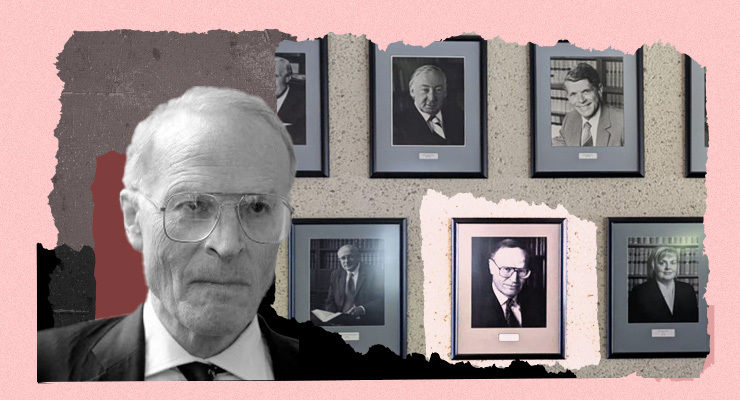
The peak body for women lawyers and barristers across the country, Australian Women Lawyers, has called for the portrait of former justice Dyson Heydon to be removed from the High Court of Australia in Canberra following verified allegations of sexual harassment against him.
Heydon’s portrait hangs prominently above a staircase in the building, surrounded by portraits of other notable judges including Lionel Murphy, Susan Crennan, William Gummow and Ronald Wilson.
His picture remains there despite having allegations of sexual harassment against him upheld by an independent investigation by the High Court.
President of the peak body, South Australian barrister Leah Marrone, told Crikey the photo should be removed from the public areas of the court immediately, and that Heydon should be stripped of his Companion of the Order of Australia (AC).
“While a pictorial historical record can be kept, it is about how it is done and whether where it is placed, or given prominence, glorifies Mr Heydon or simply records his presence as a former justice,” Marrone said.
“Given that the investigation, conducted by Dr Vivienne Thorn AM, found that six former court staff members who were judges’ associates were sexually harassed by him, this should be ample reason to remove not only his portrait from public areas of the courts but also his AC title.
“Importantly these actions would give a signal to the profession, and the public more generally, that it does not matter who you are or what position or title you hold (or held), this conduct is completely unacceptable”.
Marrone’s call echoes those of four other prominent AC recipients, an exclusive report by Crikey found this week.
Heydon’s presence remains
In 2019 the High Court launched an independent investigation by Thom into the allegations of six young female associates, which were upheld. Heydon denies the findings of predatory behaviour and declined to participate in the inquiry.
Three of those women — Chelsea Tabart, Alexandra Eggerking and Rachael Collins — have received a historic financial settlement and an apology from Attorney-General Michaelia Cash. The settlement took 20 months to be finalised, with the government accused of prolonging negotiations and delaying resolution. The amount of money the women received remains secret.
While three of the six women were compensated in what’s seen to be an admission of guilt of the government’s failure to protect women in the workplace, Heydon’s presence remains. His photo is also placed in the judges’ chambers of the NSW Supreme Court — out of view of the public but in plain view of associates and judges.
The court said it has a photographic record of all judges who have been members of the NSW Court of Appeal since its inception and did not display the photos publicly. It didn’t respond to Crikey’s questions about whether the portrait would be removed.
Heydon’s portrait isn’t his only presence in Australian courts. He was a professor of law at Sydney University and a dean of the university law school. From 2000 he was appointed to the NSW Court of Appeal before being appointed to the High Court in 2003, replacing the only female justice, Mary Gaudron. After his retirement in 2013 he headed the Royal Commission into Trade Union Governance and Corruption.
Known as a “black-letter” judge with a conservative and strict take on laws, Heydon said in a speech shortly before being appointed to the High Court that he believed judges should interpret the law “according to the books” and do so “incorruptibly”.
As such, running into his case law is inevitable. But running into his portrait at a workplace shouldn’t be. The High Court didn’t respond to Crikey’s multiple requests for comment about why the portrait was still hanging or whether it would be removed.
Although Heydon has faced ramifications following the court’s finding — he let his practising certificate lapse and has largely been absent from public life — his portrait sends a message that prominence overrides years of predatory behaviour.
Lawyers, associates or even victims of crime in the court will have Heydon’s sly smile staring down at them long after he stepped away from public life.








This is exactly where proper disapproval crosses the line into foolish cancel culture. The photographs are a record of everyone who has served on the High Court. They say nothing more than “this person served on this Court during these years”. It does not say of any of them – this one was excellent, this one lazy, this one, while convicted then acquitted of a crime, was nevertheless probably unfit to be a judge, etc etc. History must still offer complete and uncensored records of things. Orwellian airbrushing of the historical record is dangerous. And it is frankly a little hysterical to say “his portrait sends a message that prominence overrides years of predatory behaviour”. His portrait says “here is a complete set of photographs of everyone who has served on this Court”.
If his portrait remains then victims should have their own portraits hung on the roof, looking down on them all.
Historically speaking, who would want to be associated with Dirty Dyson? And for the public record, hang him in the natural history museum next to the dinosaur exhibit.
I’m all for cancelling this sort of predatory culture.
Oh nonsense. He used as creepy cover for his disgusting crimes the very building of the High Court itself, to trash and pollute one the very few arms of Australian governance for which I still have some smidgin of respect.
If I were Kiefel, why not leave his name there, under blank wall. There is your Person X on Court Y for Years Z.
Thanks for explaining something that’s been puzzling me for weeks….why is Crikey pursuing the Heydon story so doggedly?
” he headed the Royal Commission into Trade Union Governance and Corruption. Known as a “black-letter” judge with a conservative …”
Does Crikey do these 10 part exposes on anyone other than conservatives?
21 and counting news items specifically about his sexual assaults, and countless more references in Crikey worm etc.